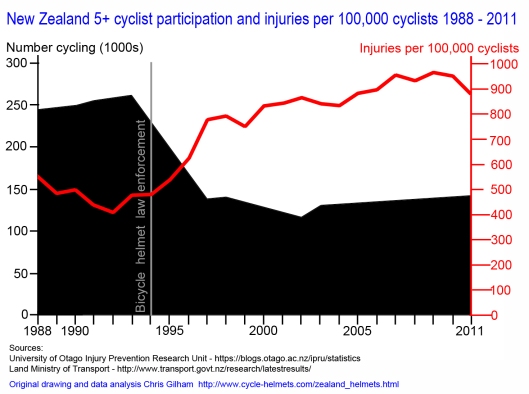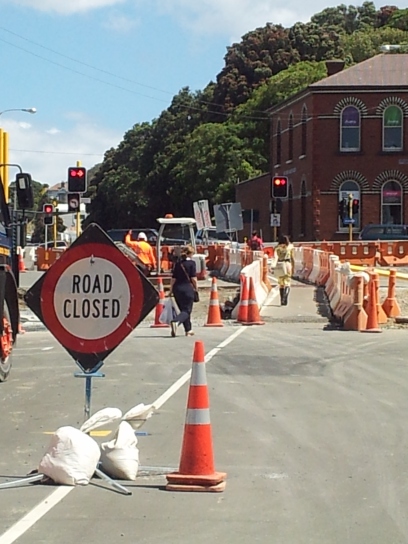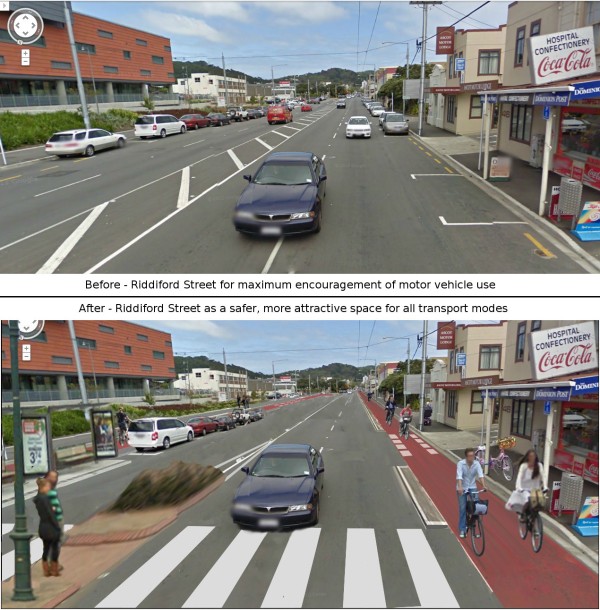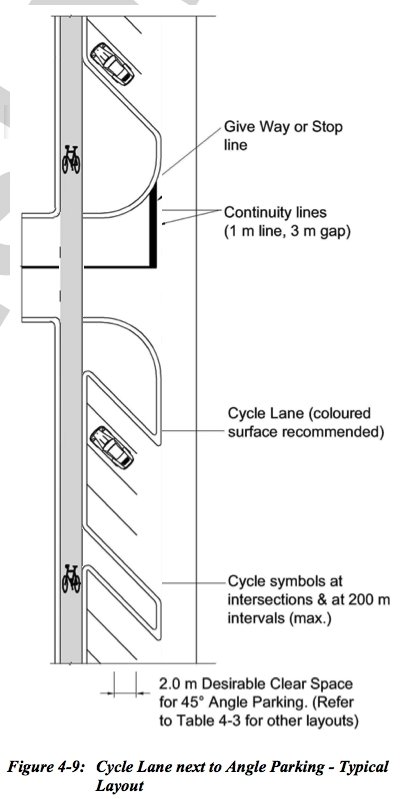What with Schumacher’s helmeted skiing fall in the news and this new graph (above) from Chris Gilham doing the rounds, I thought it high time to post the following.
For lots of reasons I won’t go into here, a little over three years ago I moved to New Zealand.
Along with Australia, NZ’s one of those places that all non-sporty cyclists avoid like the plague. Back home in Europe, people who ride bikes tend to be aware of these two countries’ bizarre, victim-blaming bicycle helmet laws. They tend to know that these laws haven’t worked and have allowed politicians, motorists and traffic engineers to ignore effective bicycle safety measures in favour of helmet crackdowns.
Happy New Year to all of you! To see in 2014, my wife and I went camping. The large campsite an hour from the capital, Wellington, was packed full of families with kids. With bicycles! People rarely drive much in a campsite and then at under 10 kph, so this was a very safe place to ride a bike. And almost all the kids (and some adults) were riding round on bikes. On the grass, on the tarmac road, on the gravel walkways (not easy!). Not a single helmet anywhere. (In truth, I saw one, dangling from a kid’s handlebars as her dad walked alongside the bike.) Looking around, it seemed shockingly evident that mainstream New Zealand has little firm belief in helmets.
In my three-plus years in NZ, I’ve noticed New Zealand is being increasingly exposed to images of helmet-free people on bikes through advertising too. Moreover, around Wellington this summer, the number of helmet-free riders I’m seeing is, on many days, more than the number of helmeted ones.
Are these not signs of a tide turning?
In 1994, the NZ government brought in the bicycle helmet law. The main impetus for it was one woman whose son was knocked off his bike by someone driving a car. The woman was Rebecca Oaten (aka. ‘the helmet lady’) from the university town of Palmerston North. And her son Aaron. Aaron was riding his mountain bike to school at the moment he was hit by a motorist and lived the rest of his life (until his sad passing in 2010) as a tetraplegic.
Absurdly, Oaten then toured the country for six years, driving to four schools a day (therefore probably endangering schoolchildren all over the country) to ‘furiously‘ promote bicycle helmets which are not and have never been designed for collisions with motor vehicles. Her emotive (largely science-free) crusade around New Zealand schools is responsible for frightening kids into deep fear of helmet-free cycling (and cycling itself) and ensuring parents all over the country drive their kids to school – contributing hugely to road danger during school commutes.
Oaten formed a lobby group to pressure the government to implement a helmet law. The rest is history.
Palmerston North is almost completely flat. It’s less than 10km from side to side. It is also home to a major university and a large polytechnic college. It therefore has everything to be an obvious cycling town. But it also has awful cycle lanes for the hometown of NZ’s staunchest bicycle safety campaigner. The cycle lanes are not protected from motor vehicles, are invariably on the wrong side of parked cars, and are more often than not filled with (legally!) parked cars. Percentage of people who get around by bike? 5%.

Palmerston North: pedestrian build-outs and car parking spaces render most of the city’s bicycle lanes unusable.
The helmet law had the effects observed in Gilham’s graph above. No-one seems sure how much of this is due to helmets being uncomfortable, the inconvenience of having to buy/wear/carry/store one, the dangerising of helmet-free cycling, the dork factor, or simply not enjoying being hassled and fined by the police for not wearing one. All of the above?
Moreover, the demographic group hardest hit by the law was the safest bicycle riders. The remaining riders – sporty and risk-taking – now get into more crashes because they ride too fast to avoid problems (from Australia: Monash Cyclist Crash Study Report 311, 2012: 44% of cyclists who crashed were riding drop-bar racing bikes, 47% were wearing cleated cycling shoes). The effect on the ‘average’ safety of cyclists is clear from Gilham’s graph above. The safer cyclists may well still be as ‘safe’ as they were previously – despite lowered safety in numbers – but they are few compared to the racers.
Here’s what should have happened, had Ms. Oaten channelled her energies in a less victim-blaming, more danger-preventing direction. The Netherlands had a similarly emotional and hard-hitting public campaign against the main cause of road danger: cars. Stop the Child Murder.
It’s easy to imagine what the wide streets of New Zealand towns could look like with safe, Dutch infrastructure.
Ms Oaten has acknowledged that more people would ride bikes if they did not have to wear a helmet, “but how many of those would end up brain-damaged or dead?” For the record, my partner works in neurosurgery – that’s medical jargon for dealing with head injuries. The number of bicyclists she has seen in 4 years? Zero. Number of seriously head-injured motorists? Many. Ms Oaten says “if it prevents one injury [the helmet law] is worth it” but fails to see that making it compulsory for car occupants to wear crash helmets would definitely save far more brain injuries in absolute numbers per year. For some reason she hasn’t made that suggestion yet.
The most common cause of devastating, life-changing brain damage that my partner sees? Strokes, due in large part to inactive lifestyles.
Well done, Ms Oaten, well done.













